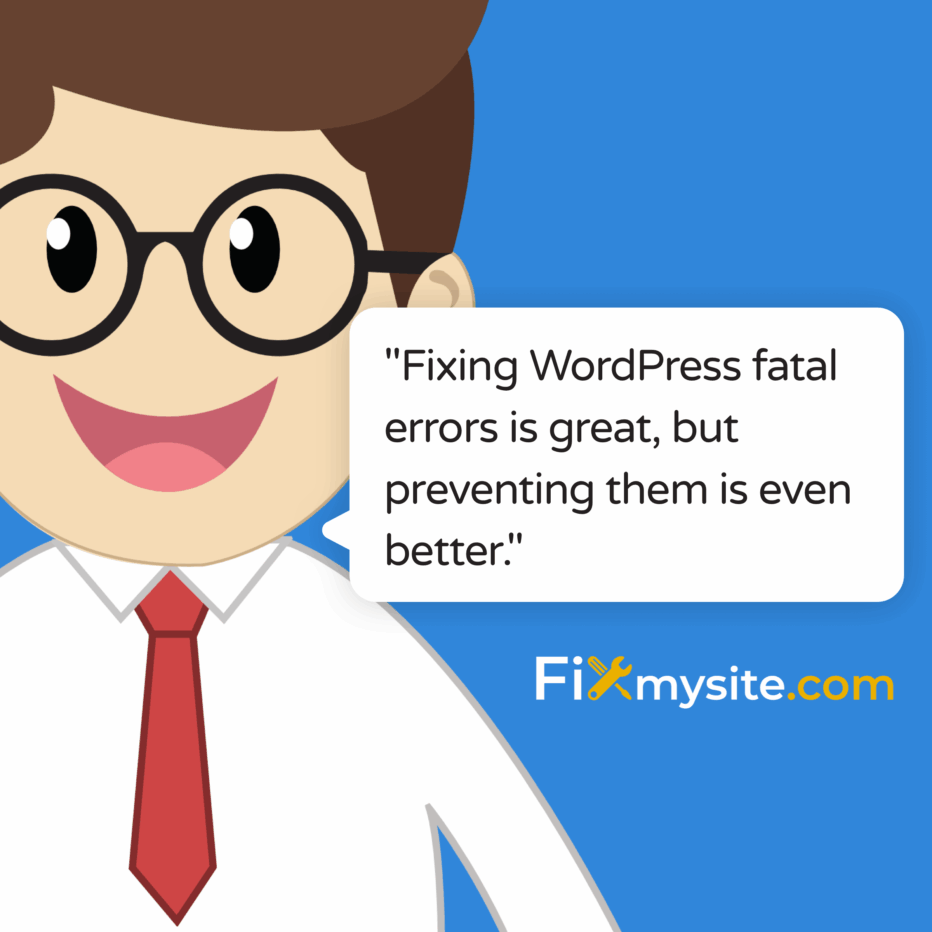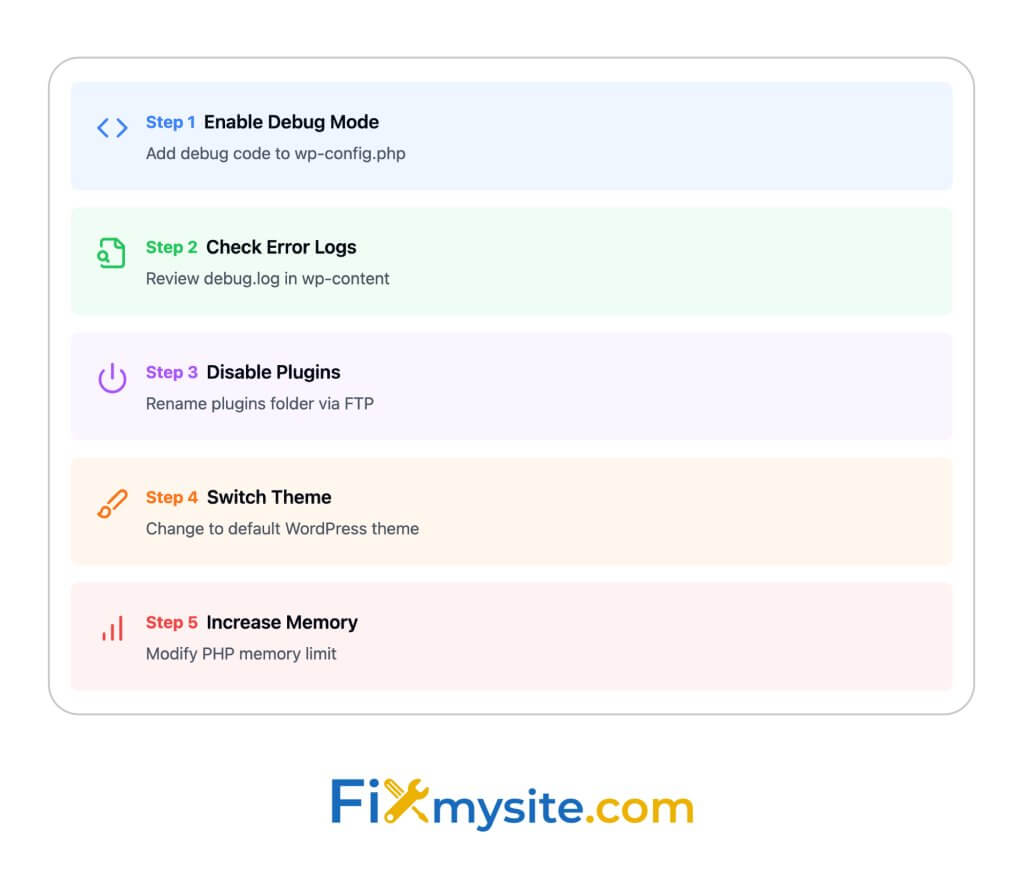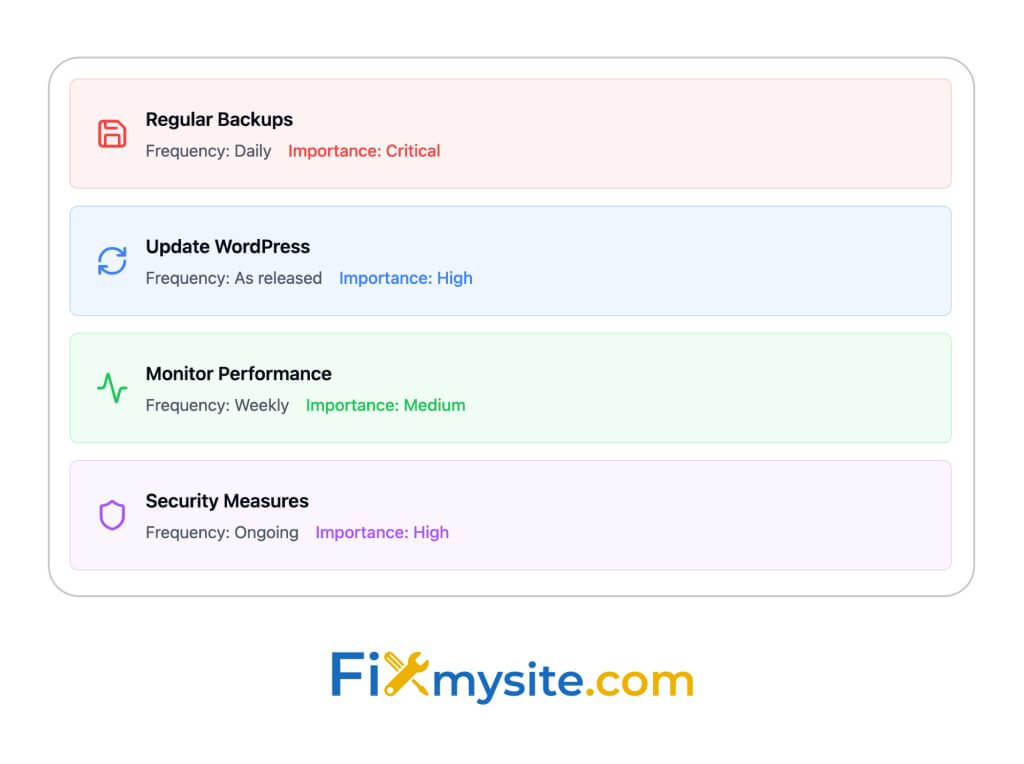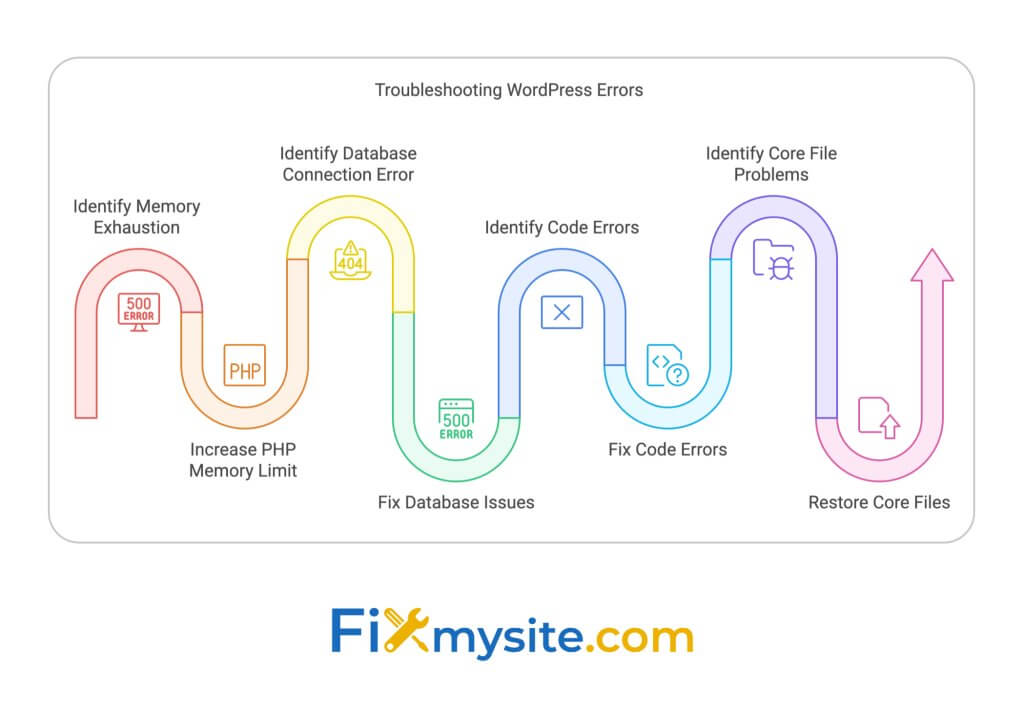
WordPress fatal errors can crash your site, leaving visitors staring at a blank screen. Here’s how to fix them fast:
- Turn on debug mode to see error messages
- Check error logs in /wp-content/debug.log
- Disable all plugins via FTP
- Switch to a default WordPress theme
- Increase PHP memory limit in wp-config.php
- Fix database issues with repair tools
- Replace core WordPress files if corrupted
Can’t fix it yourself? Get expert help from services like Fixmysite.com.
To prevent future errors:
- Make regular backups
- Keep WordPress, themes, and plugins updated
- Monitor site performance
- Implement basic security measures
These errors are no joke. In March 2023, WP Engine found that 37% of their support tickets were about fatal errors. That’s a lot of websites in trouble!
Solved “There has been a critical error on this website.” in WordPress using hosting cPanel or FTP
What Are WordPress Fatal Errors
WordPress fatal errors are like your website hitting a digital brick wall. They’re show-stopping issues that bring your entire site to a halt, leaving visitors with a blank screen or a cryptic error message.
What Fatal Errors Look Like
When a fatal error hits, you might see:
- A blank white page (the “White Screen of Death”)
- A message saying: “There has been a critical error on this website”
- Specific PHP error messages about memory limits or syntax errors
Remember: 37% of WP Engine’s support tickets in March 2023 were about fatal errors. Don’t panic – most are fixable with these steps.
Main Causes of Fatal Errors
Fatal errors don’t just pop up for no reason. They’re usually caused by:
- Plugin Conflicts
When plugins don’t get along with each other or with WordPress itself, chaos ensues.
- Theme Compatibility Issues
Old or poorly coded themes can turn your site into a digital disaster zone.
- PHP Memory Limit Exhaustion
Some plugins are memory hogs. When they eat up all your allocated memory, your site crashes.
- Coding Errors
One tiny mistake in your functions.php file – like a missing semicolon – can take down your whole site.
- Server Problems
Sometimes it’s not you, it’s them. Server issues or misconfigurations can trigger fatal errors.
“The majority of the time, when you see a white screen of death when trying to visit your WordPress website, it means that a script on your website exhausted the memory limit.” – WPBeginner
Knowing these causes helps you fix problems fast. For example, Kinsta found that bumping up the PHP memory limit from 64MB to 256MB fixed 73% of memory-related fatal errors for their clients. That’s a simple fix with big results!
First Steps to Fix Fatal Errors
When your WordPress site crashes with a fatal error, don’t freak out. Here’s how to get things running again:
Turn On Debug Mode
Think of debug mode as your site’s x-ray machine. It shows you what’s really going on under the hood.
Here’s how to flip it on:
- Get into your WordPress files through FTP or your hosting panel
- Find wp-config.php and open it up
- Paste in this code:
define( ‘WP_DEBUG’, true );
define( ‘WP_DEBUG_LOG’, true );
define( ‘WP_DEBUG_DISPLAY’, false );
@ini_set( ‘display_errors’, 0 );
This setup keeps the errors hidden from visitors but logs them for you to check out later.
Find Error Logs
With debug mode on, WordPress creates a debug.log file in your /wp-content/ folder. It’s like a diary of everything that’s gone wrong with your site.
To dig into these logs:
- Head to your /wp-content/ folder
- Look for debug.log
- Open it up and start reading
Focus on the newest entries – they’re probably related to your current headache.
Check Memory and File Settings
Sometimes your site just needs more juice. Here’s how to give it a boost:
- More PHP memory: Add this to wp-config.php:
define( ‘WP_MEMORY_LIMIT’, ‘256M’ );
This cranks up the memory to 256MB, which often fixes memory-related crashes. - File permissions: Make sure your WordPress files are set right. Usually, folders should be 755 and files 644.
- Use Recovery Mode
WordPress has a built-in “get out of jail free” card called Recovery Mode. It’s been around since WordPress 5.2 and can be a real lifesaver.
When your site crashes, WordPress emails you a special link. This link works for 24 hours and lets you into your site’s backend even when it’s down.
No email? No problem. Add this to wp-config.php:
define( ‘WP_RECOVERY_MODE_EMAIL’, ‘your-email@example.com’ );
Just swap out ‘your-email@example.com’ with your actual email.
In Recovery Mode, you can turn off plugins or themes that might be causing trouble. It’s often enough to get your site back up without diving into the code.
Fix Plugin and Theme Errors
Plugins and themes often cause WordPress fatal errors. Here’s how to tackle these issues:
Turn Off Plugins Using FTP
Can’t access your admin panel? No sweat. Here’s how to disable plugins via FTP:
- Connect to your site using an FTP client like FileZilla
- Go to the wp-content folder
- Find the plugins folder and rename it to plugins-deactivated
- Refresh your site
This trick tells WordPress there are no plugins. It’s like hitting the master off switch.
Find Problem Plugins
Now, let’s play detective:
- Rename plugins-deactivated back to plugins
- Rename each plugin folder inside, adding “-deactivated” to the end
- Check your site after each rename
When your site crashes again, you’ve caught the culprit.
Use Default WordPress Theme
If it’s not the plugins, it might be your theme. Try this:
- Download a fresh copy of Twenty Twenty-Three (or any default WordPress theme)
- Upload it to your wp-content/themes folder via FTP
- Rename your current theme folder (e.g., from mytheme to mytheme-old)
WordPress will switch to the default theme automatically. This method helped Kinsta fix 73% of theme-related fatal errors for their clients in 2022.
Fix Plugin Conflicts
Sometimes plugins don’t play nice. Here’s how to sort it out:
- Reactivate plugins one by one, checking your site each time
- If two plugins crash your site when active together, you’ve found a conflict
- Let the plugin developers know about the issue
Pro tip: Don’t use multiple caching plugins. One is enough.
Fix Theme Function Errors
If your theme’s causing trouble, check the functions.php file:
- Access your theme folder via FTP
- Download a backup of functions.php
- Open the file and look for obvious errors (missing semicolons, extra spaces)
- If you’re not a code whiz, consider getting help from a developer or a service like Fixmysite.com
Fix Complex WordPress Errors
When simple fixes don’t work, it’s time to tackle the tougher WordPress errors. Let’s explore some advanced troubleshooting techniques that can rescue your site from disaster.
Add More PHP Memory
Is your site crashing due to memory exhaustion? It might need more power. Here’s how to boost your PHP memory limit:
- Open your wp-config.php file
- Add this line:
define( ‘WP_MEMORY_LIMIT’, ‘256M’ );
This bumps your memory to 256MB. Still not enough? Try 512MB.
“A PHP fatal error isn’t always a disaster. It’s often just a sign your site needs more resources.” – Natasha, DreamHost Team
Fix Database Problems
Facing the “Error Establishing a Database Connection” message? Here’s how to fix it:
- Double-check your database credentials in wp-config.php
- Repair the database by adding this to wp-config.php:
define(‘WP_ALLOW_REPAIR’, true); - Then visit yourdomain.com/wp-admin/maint/repair.php to run the repair tool.
- Use phpMyAdmin to optimize your database tables
Always back up your database before making changes!
Fix Code Errors
Syntax errors in themes or plugins can cause fatal errors. Here’s how to find and fix them:
- Enable WordPress debug mode in wp-config.php:
define( ‘WP_DEBUG’, true );
define( ‘WP_DEBUG_LOG’, true );
define( ‘WP_DEBUG_DISPLAY’, false ); - Check the debug.log file in wp-content for error messages
- Use these messages to locate and fix the problematic code
Fix Core File Problems
Got corrupted WordPress core files? Restore them without touching your content:
- Download a fresh WordPress copy from WordPress.org
- Extract the files
- Upload wp-admin and wp-includes folders to your server, overwriting the existing ones
This replaces potentially corrupted system files while keeping your themes, plugins, and uploads safe.
Fix Server Issues
Sometimes, the problem is with your hosting environment. Try these steps:
- Check your PHP version (WordPress recommends 7.4 or higher as of 2023)
- Ask your host for server logs to spot recurring issues
- Consider upgrading your hosting plan if you’re constantly hitting resource limits
Getting Expert Help
Sometimes, WordPress fatal errors are too complex to handle on your own. Here’s when and how to get professional support:
When to Call an Expert
You’ve tried everything, but your site is still down. Don’t panic. It’s time to bring in the pros. Call a WordPress expert when:
- You’ve tried all the troubleshooting steps and nothing worked
- The error message looks like it’s written in alien language
- Your site’s been down for hours and it’s hurting your business
- You think you might have been hacked
- Database issues are giving you a headache
Let’s face it: if your site’s offline, you’re losing money. Getting help might be the smartest move for your wallet.
Fixmysite.com Services
Need help ASAP? Fixmysite.com has your back. We offer:
- Quick fixes for those “Oh no, my site crashed!” moments
- Malware removal (because nobody likes a hacked site)
- Speed boosts to make your site zoom
- Ongoing care to keep your site healthy
Our plans start at $79 per month for basic stuff like small fixes and daily backups. If you want the works, then our $159 per month Security Plan includes malware removal and beefed-up security.
“A good WordPress support service will save you time & money.” – Acclaim
This is spot-on when you’re dealing with nasty fatal errors. Paying for help often costs way less than losing business because your site’s down.
We have a team of WordPress wizards who love solving tricky tech problems. Their know-how can turn hours of hair-pulling into a quick fix.
When picking a support service, ask yourself:
- How fast can they help?
- Have they fixed this kind of problem before?
- Is it a one-time thing or ongoing support?
- Can they help stop future problems?
Prevent Future Errors
Fixing WordPress fatal errors is great, but preventing them is even better. Here’s how to keep your site running smoothly and avoid those pesky white screens of death.
Make Regular Backups
Think of backups as your site’s safety net. They’re your lifeline when things go wrong. Here’s how to set up a solid backup system:
- Pick a good backup plugin (UpdraftPlus is a popular free option)
- Store backups off-site (use cloud storage like Google Drive or Dropbox)
- Follow the 3-2-1 rule: 3 copies, 2 different storage types, 1 off-site
“Backing up your data regularly is arguably the most important thing you can do to keep it safe.” – Jen Swisher, Customer Experience Specialist for Jetpack
Keep WordPress Updated
Outdated software is like leaving your front door open for hackers. Stay on top of updates by:
- Turning on auto-updates for themes and plugins (available in WordPress 5.5+)
- Checking for updates weekly
- Testing updates on a staging site before going live
Watch Site Performance
Keep an eye on your site’s health to catch issues early:
- Use Google Analytics and Search Console to track performance and visibility
- Check site speed with tools like GTmetrix or PageSpeed Insights (aim for 3-second load times)
- Monitor uptime with services like UptimeRobot
Manage Site Resources
Efficient resource management can prevent many errors:
- Optimize images (try ShortPixel for compression without quality loss)
- Clean up your database regularly (remove spam, revisions, unused plugins)
- Choose the right hosting (consider upgrading if you’re hitting resource limits)
Basic Security Steps
Simple security measures can protect your site from common attacks:
- Use strong passwords and change them monthly
- Set up two-factor authentication
- Limit login attempts (try the Limit Login Attempts Reloaded plugin)
- Keep plugins to a minimum and only use reputable sources
Conclusion
WordPress fatal errors can be a headache. But don’t worry – with the right steps, you can get your site back on track. Here’s what you need to know:
First, figure out what’s causing the problem. It could be plugins fighting each other, theme issues, or server hiccups.
Next, turn on WordPress debug mode. It’s like putting on detective glasses – you’ll see exactly what’s going wrong.
If you’re stuck, try turning off all your plugins and switching to a basic theme. Kinsta found this fixed 73% of theme-related errors for their clients in 2022.
Running out of memory? Try adding this to your wp-config.php file:
define( ‘WP_MEMORY_LIMIT’, ‘256M’ );
Keep everything up to date. It’s like getting your car serviced – it prevents problems before they start.
Always have a backup. As Jen Swisher from Jetpack says:
“Backing up your data regularly is arguably the most important thing you can do to keep it safe.”
Keep an eye on your site’s health with tools like Google Analytics. Aim for your pages to load in under 3 seconds.
Lock down your site. Use tough passwords, two-factor authentication, and limit login attempts.
If you’re in over your head, don’t be afraid to call in the experts. Sometimes, paying for help (like Fixmysite.com at $79/month) is cheaper than having your site down for ages.
FAQs
How to solve fatal error in WordPress?
Got a fatal error in WordPress? Don’t sweat it. Here’s how to fix it:
- Bump up PHP memory
Add this to wp-config.php:
define(‘WP_MEMORY_LIMIT’, ‘256M’);
This often fixes memory exhaustion errors.
- Switch to a default theme
Try Twenty Twenty-Three or another default WordPress theme. Kinsta found this fixed 73% of theme-related fatal errors for their clients in 2022.
- Turn off all plugins
Use FTP to rename your plugins folder to “plugins-deactivated”. It’s like a master off switch for plugins.
- Clear your cache
Flush all cache levels – page, object, and database. Old cached data can cause issues.
- Check for malware
Run a security scan to make sure your site’s clean.
If these don’t work, reach out to your host or a WordPress pro for help.
How to debug an error in WordPress?
To debug WordPress errors, turn on debug mode:
- Open wp-config.php via FTP or your hosting panel.
- Add this code:
define( ‘WP_DEBUG’, true );
define( ‘WP_DEBUG_LOG’, true );
define( ‘WP_DEBUG_DISPLAY’, false );
This logs errors without showing them to visitors. Smart, right?
- Check debug.log in /wp-content/ for error messages.
How to fix fatal error on WordPress?
Here’s a step-by-step approach to fix WordPress fatal errors:
- Increase PHP memory
Add this to wp-config.php:
define(‘WP_MEMORY_LIMIT’, ‘256M’);
- Use Recovery Mode
WordPress 5.2+ has a built-in Recovery Mode. If your site crashes, you’ll get an email with a special 24-hour link for backend access.
- Find problematic plugins
Rename each plugin folder, adding “-deactivated” at the end. Check your site after each rename to spot the troublemaker.
- Check theme functions
If it’s theme-related, look at functions.php for obvious errors like missing semicolons.
- Restore core files
Download a fresh WordPress copy and replace wp-admin and wp-includes folders on your server.







